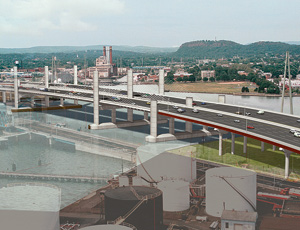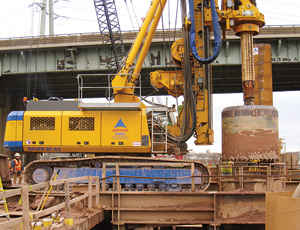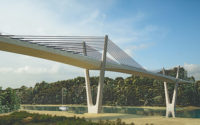Foundation work for a signature bridge is under way as part of a $2.2-billion Interstate corridor project in Connecticut. Critical elements include constructing the nation’s first extradosed bridge and beefing up commuter rail service in what Connecticut Dept. of Transportation officials say is the largest single construction effort ever undertaken by the agency.



The 7.5-mile-long I-95 New Haven Harbor Crossing Corridor Improvement Program, extending from the Long Wharf area in New Haven to nearby Branford, is designed to alleviate traffic problems in a densely developed urban area. Originally designed in the late 1950s to carry 40,000 vehicles daily, the stretch of road now handles over 140,000 vehicles per day. Central to the project is the Pearl Harbor Memorial Bridge, known locally as the Q-bridge because it spans the Quinnipiac River.
“The Q-bridge has often been called the gateway to New England,” says Brian Mercure, ConnDOT assistant district engineer, who says the 51-year-old bridge is now structurally deficient and functionally obsolete.
The six-lane steel-plate girder bridge is being replaced by a three-span 1,013-ft-long side-by-side extradosed structure, a hybrid cable-stayed, box-girder bridge with shortened pylons required to meet air-traffic restrictions from nearby Tweed New Haven Airport.
The term “extradosed” refers to the outer surface of an arch bridge. These types of bridges were first built about 15 years ago in Japan.
“The extradosed prestressed concept performs structurally more closely to an externally prestressed girder bridge than a cable-stayed bridge,” says Steven L. Stroh, main-span design manager with URS Corp., whose Rocky Hill, Conn., office is the lead design engineer. “The girders are the primary load path, while the cables prestress the girders.” The finished structure will have six 144-ft-tall tower legs and six anchor piers. Each tower, projecting 75 ft above the deck, supports two planes of eight cables.
The first section of the new Q-bridge will be built between the existing I-95 bridge and the vertical-lift Tomlinson Bridge, which carries U.S. Route 1 and rail traffic. Once in place, the existing I-95 bridge will be deconstructed and the second span erected. The new structures will be separated by a 10-ft open medium. When complete in 2016, the new Q-bridge will carry 10 lanes with tapered auxiliary lanes and shoulders. The bridge will vary in width from 96 ft to 108 ft.
According to ConnDOT, the extradosed bridge supports a 515-ft-long center span, a length which enables foundation work that will not interfere with existing I-95 foundations. That bridge has a 387-ft center span. Maintenance costs are reduced because stay cables do not need tension adjustment, and girder depth is reduced, further enhancing the longer span and 64-ft shipping clearance while supporting the tie-in to existing steel-plate girder approaches. Each new bridge will have two 249-ft-long side spans.
“The selection of the extradosed prestressed bridge was the outcome of a detailed study that considered initial construction cost, life-cycle cost based on a 100-year design life, constructibility, maintenance, aesthetics and environmental impacts,” says James A. Platosh, URS project manager. ConnDOT and the Federal Highway Administration reviewed numerous truss types and plate- and box-girder alternatives before selecting the hybrid.
Work on the $137-million foundation is being completed by the joint venture of Pittsfield, Maine-based Cianbro Cos. and Middlesex Corp.(CMJV), Littleton, Mass., which is building steel-framed trestles and sheetpile cofferdams for construction access. Four 5,600-sq-ft cofferdams protect the drilling of 42 8-ft-dia steel casings up to 200 ft long. Crews from Raito Inc., Woburn, Mass., are screwing the casings six ft into rock using a Supertop rotator rig. Overburden is removed, and then 9-ft to 30-ft sockets are drilled into rock.
“We can seal the casing into the rock, which makes construction of the sockets easier,” says Brannin Beeks, Raito project manager. The shafts will support 12-ft-thick cast-in-place reinforced-concrete mats. CMJV also will install 48,000 ft of concrete pile for northbound ramp approaches.
The superstructure already is out to bid for a June 3 opening. To enhance competition, the package contains two bridge alternatives, for concrete and steel composite. Work was originally bid in May 2006, but there were no takers. ConnDOT revised the package, reducing scope and risk and making adjustments for materials and diesel fuel. “The department reached out to the find out what was needed to get bidders from the constructing community,” says Mercure. “They wanted a reduced contract in size and duration.”
The entire corridor project is broken into nine main packages. Work totaling about $203 million, including a new commuter rail station and four miles of I-95 improvements, already is complete and a $19.5-million contract relocating twin 42-in-dia. force mains is wrapping up. Besides the Q-bridge foundations, work also is under way on a $91.4-million I-95 northbound flyover. Other projects include emergency repairs this year to the existing Q-bridge, for $2.9 million, and reconstructing the I-95/I-91/State Route 34 interchange in New Haven. It is to be awarded in 2011.



Post a comment to this article
Report Abusive Comment